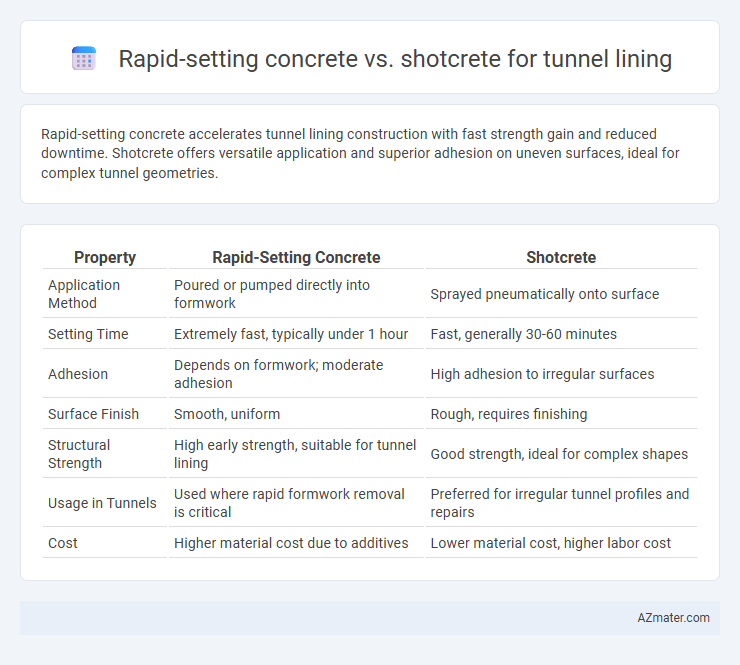Rapid-setting concrete accelerates tunnel lining construction with fast strength gain and reduced downtime. Shotcrete offers versatile application and superior adhesion on uneven surfaces, ideal for complex tunnel geometries.
Table of Comparison
| Property | Rapid-Setting Concrete | Shotcrete |
|---|---|---|
| Application Method | Poured or pumped directly into formwork | Sprayed pneumatically onto surface |
| Setting Time | Extremely fast, typically under 1 hour | Fast, generally 30-60 minutes |
| Adhesion | Depends on formwork; moderate adhesion | High adhesion to irregular surfaces |
| Surface Finish | Smooth, uniform | Rough, requires finishing |
| Structural Strength | High early strength, suitable for tunnel lining | Good strength, ideal for complex shapes |
| Usage in Tunnels | Used where rapid formwork removal is critical | Preferred for irregular tunnel profiles and repairs |
| Cost | Higher material cost due to additives | Lower material cost, higher labor cost |
Introduction to Tunnel Lining Methods
Rapid-setting concrete offers accelerated curing times essential for minimizing downtime in tunnel lining, ensuring structural stability under high-stress conditions. Shotcrete, applied pneumatically, provides flexible layering and adapts to complex tunnel geometries, enhancing adhesion and reducing material waste. Selecting between rapid-setting concrete and shotcrete depends on project requirements such as setting time, application environment, and structural performance needs.
Overview of Rapid-Setting Concrete
Rapid-setting concrete is engineered for accelerated curing times, enabling early strength gain crucial in tunnel lining applications where minimizing downtime is essential. This type of concrete employs high-reactivity cementitious materials and specialized admixtures to achieve setting times from a few minutes to a couple of hours. Its fast hardening properties make it ideal for environments requiring rapid stabilization, such as shotcrete layers in tunneling projects that demand immediate support and reduced construction schedules.
Introduction to Shotcrete Technology
Shotcrete technology involves the application of concrete conveyed through a hose and pneumatically projected at high velocity onto a surface, providing excellent adhesion and compaction for tunnel lining. Rapid-setting concrete is often used in shotcrete to accelerate curing times, enabling faster construction progress and early load-bearing capacity in underground environments. The combination of shotcrete application and rapid-setting mixtures enhances structural stability and reduces downtime during tunnel excavation and lining installation.
Installation Process Comparison
Rapid-setting concrete offers faster curing times, allowing tunnel lining installations to proceed with minimal delays and reduced formwork time, making it ideal for projects requiring quick turnaround. Shotcrete, applied pneumatically without formwork, enables flexible placement on irregular surfaces and immediate adhesion, reducing labor and equipment needs in confined tunnel environments. Both methods improve efficiency, but rapid-setting concrete demands precise mixing and placement, while shotcrete requires skilled nozzle operators to ensure uniform application and structural integrity.
Setting Time and Strength Development
Rapid-setting concrete achieves initial setting within 30 to 60 minutes and reaches 70% of its design strength in 24 hours, making it ideal for projects requiring quick turnaround. Shotcrete, applied pneumatically, typically sets in 20 to 40 minutes and gains strength rapidly, often achieving structural capacity within hours due to its dense microstructure. Both materials optimize tunnel lining performance, but shotcrete provides superior early-age strength development with faster setting times crucial for overhead and complex geometries.
Durability and Long-Term Performance
Rapid-setting concrete offers accelerated curing times and high early strength, making it ideal for quick tunnel lining repairs but may have reduced long-term durability under aggressive environmental conditions. Shotcrete provides superior adherence to complex tunnel surfaces with enhanced durability due to its dense microstructure and ability to incorporate fiber reinforcement, improving crack resistance and extending service life. Long-term performance of shotcrete generally surpasses rapid-setting concrete in maintaining structural integrity and resisting moisture and chemical ingress in tunnel linings.
Cost Implications and Resource Requirements
Rapid-setting concrete reduces overall construction time in tunnel lining projects, lowering labor costs and minimizing downtime; however, specialized additives increase material expenses compared to traditional mixtures. Shotcrete application demands skilled labor and specialized equipment, which raises initial investment and operational costs but offers faster placement and reduced formwork needs, cutting long-term expenditures. Balancing these factors depends on project scale and timeline, where rapid-setting concrete suits time-critical jobs, while shotcrete optimizes resource utilization for complex geometries.
Safety Considerations for Tunnel Construction
Rapid-setting concrete offers enhanced safety in tunnel lining by significantly reducing setting time, which minimizes the risk of water ingress and tunnel face instability during construction. Shotcrete provides superior adhesion to irregular surfaces, improving structural support and decreasing hazards related to loose rock fall and surface erosion. Both materials contribute to safer tunnel construction environments by accelerating stabilization processes and reducing exposure duration for workers.
Environmental Impact and Sustainability
Rapid-setting concrete reduces construction time and minimizes environmental disruption compared to traditional methods, offering enhanced sustainability through lower energy consumption during curing. Shotcrete, with its pneumatic application, decreases material waste and allows for precise layering, reducing the carbon footprint associated with overuse of concrete. Both methods contribute to sustainable tunnel lining by optimizing resource use, but rapid-setting concrete has a slight advantage in minimizing onsite emissions through faster project completion.
Best Applications: Rapid-Setting Concrete vs Shotcrete
Rapid-setting concrete excels in tunnel lining projects requiring quick load-bearing capacity and minimal downtime, making it ideal for emergency repairs and areas with limited working space. Shotcrete offers superior adaptability for complex geometries and irregular surfaces, allowing efficient application in tunnels with intricate designs or unstable rock conditions. Choosing between rapid-setting concrete and shotcrete depends on project-specific factors like structural requirements, site accessibility, and desired setting time.

Infographic: Rapid-setting concrete vs Shotcrete for Tunnel lining
 azmater.com
azmater.com